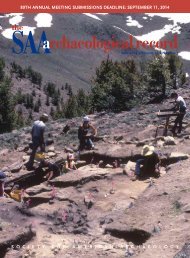SAA
Nov2016_web
Nov2016_web
You also want an ePaper? Increase the reach of your titles
YUMPU automatically turns print PDFs into web optimized ePapers that Google loves.
82ND ANNUAL MEETING<br />
JOURNEY THROUGH THE<br />
LANDSCAPES OF VANCOUVER<br />
Andrew Martindale<br />
Andrew Martindale is an associate professor in the Department of Anthropology, Peter Wall Institute for Advanced Studies, University of British Columbia,<br />
and the director of both the Laboratory of Archaeology and the Canadian Archaeological Radiocarbon Database.<br />
Vancouver is a place of many landscapes. The urban<br />
metropolis that will host the 82nd Society for American<br />
Archaeology Annual Meeting is its most visible surficial<br />
layer. Consistently ranked as one of the world’s most livable<br />
cities (Economist Intelligence Unit 2016), Vancouver boasts a<br />
dynamic and multicultural population. The desirability of living<br />
in a city by the sea enjoying the mildest climate in Canada has<br />
resulted in considerable growth since its founding in the late<br />
nineteenth century. Its citizens have wrangled with this history,<br />
enacting visionary planning policies such as the founding of the<br />
country’s largest urban park, the 405-hectare Stanley Park, as its<br />
first municipal order of business in 1886, and the rejection of<br />
urban highways in favor of public transit in the 1960s. The location<br />
of the annual meeting, the Vancouver Convention Centre,<br />
is a government-owned facility at the nexus of the urban downtown<br />
and transportation hub for floatplanes, rail, bus/seabus,<br />
and cruise ships that, among other green features, supports<br />
North America’s largest living roof and urban food garden. The<br />
city is not without its tensions, however. Population growth on<br />
a limited land base has made housing costs unaffordable for<br />
many. Social conflict along economic and cultural lines is pervasive<br />
and ongoing. Vancouver’s landscapes change with the people<br />
who walk them.<br />
These dynamics are nothing new. The place that is Vancouver<br />
has always been a mosaic of geography and ecology and a crossroads<br />
of people and their history. Surrounded by mountains,<br />
valleys, ocean, and islands, the city rests on the massive delta<br />
and terminal moraines of the Fraser River valley. Indigenous<br />
people, whose territory includes Vancouver, trace their ancestry<br />
back to beginning times, when the world was still forming, a<br />
landscape that, in archaeological terms, experienced dramatic<br />
swings in relative sea level from both isostatic and eustatic<br />
effects during the epiglacial era. Indigenous histories of this<br />
place, like all histories, reflect a complex dynamic between the<br />
constraints of circumstance and the volatility of historically contingent<br />
choices. Although the archaeological sample is modest<br />
and skewed to biases of modern demography, geology, and cultural<br />
expectation, it captures several notable trends. The first is<br />
continuity. This is a place of tradition whose indigenous-descent<br />
communities today emerge out of the long histories of their<br />
ancestors. Archaeology may exist in some contexts independent<br />
of living memory, but in Vancouver it does not. The second is<br />
balance. Indigenous society balanced the countervailing forces<br />
of demography and abundance, of conflict and negotiation, of<br />
surplus and necessity, of, as Coupland et al. argue (2009), hierarchy<br />
and communalism. The legacy is a millennia-long trend<br />
of resource-managed sustainability (see for example Lepofsky et<br />
al. 2015; McKechnie et al. 2014) that was only inverted, as<br />
Bodley (2012) argues, with the arrival of a deepening disjunction<br />
between collective goals and economic self-interest consequent<br />
to the colonial era. The third is resilience. Though visitors<br />
to Vancouver may not easily see the people or hear the voices<br />
that echo this history, it is here.<br />
Consider, for example, the Musqueam Indian Band’s reassertion<br />
of their place names and history on the urban landscape<br />
(www.musqueam.bc.ca/musqueam-our-history-web-map), the<br />
exploration of archaeology via the virtual museum of the<br />
Sq’éwlets website project (Lyons et al 2016), the Stó:lo-Coast Salish<br />
Historical Atlas (Carlson 2001), the websites for the<br />
Skwxwú7mesh Úxwumixw (http://www.squamish.net) and<br />
Tsleil-Waututh Nations (http://www.twnation.ca), and the City<br />
of Vancouver’s own First Peoples: A Guide for Newcomers (Wilson<br />
and Henderson 2014). Each of these initiatives attempts to<br />
bring to the foreground not what is hidden as much as what is<br />
missed.<br />
The tours for the 82nd annual meeting engage these ideas<br />
directly and ask you to see beyond what you perceive and consider<br />
the challenges of seeing what is there. These issues were<br />
explored in the award-winning suite of exhibits of c̓əsnaʔəm, the<br />
city before the city (www.thecitybeforethecity.com). Integrated at<br />
the Musqueam Cultural Centre, the Museum of Anthropology,<br />
and the Museum of Vancouver, only the latter will be open during<br />
the annual meeting. This tour of the exhibit is co-hosted by<br />
co-curator and Musqueam community member Jordan Wilson<br />
and renowned anthropologist and museum board member<br />
November 2016 • The <strong>SAA</strong> Archaeological Record<br />
7




